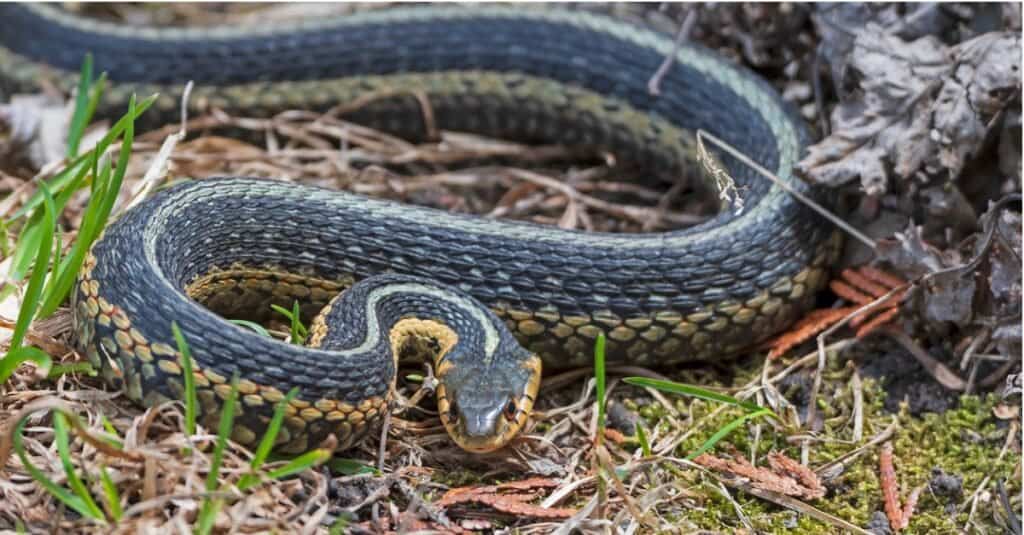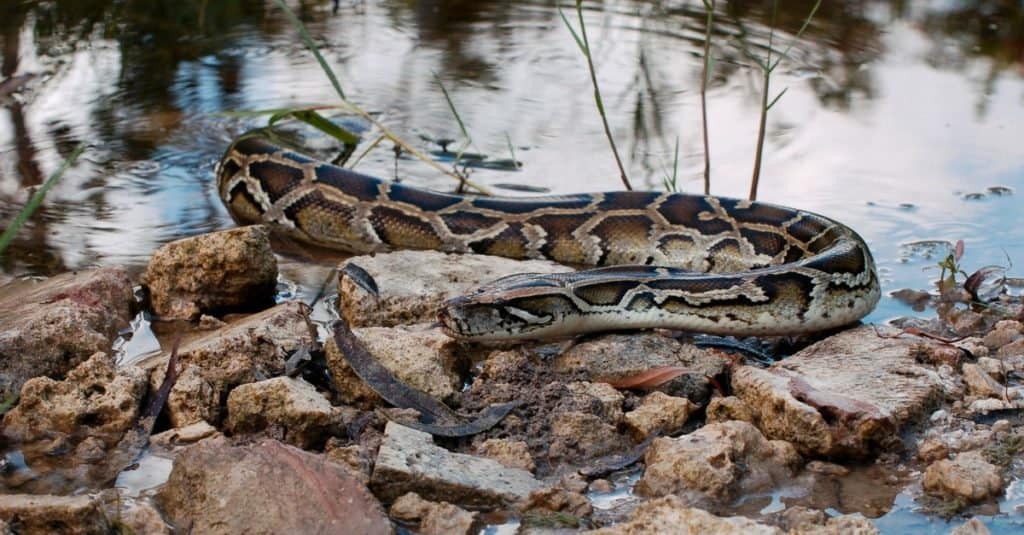Alaska is home to some of the biggest and most fearsome creatures on earth. When we think of Alaska, we picture mountains, bears, moose, and massive stretches of lush forest. As beautiful as all that is, it isn’t the ideal territory for a snake! Incredibly, one 17-foot snake was found living in Alaska.
Let’s discover the 17-foot snake that once impossibly roamed Alaska!
How did a 17-foot snake end up in Alaska?

Alaska isn’t home to snakes, but one
python
managed to do just fine!
©iStock.com/scgerding
We’ve all had a pet run away before, but in the case of a snake, it slithers! A recent story from Anchorage, Alaska, shows us that we truly have no idea what happens when our pets run away, but they do sometimes come back. In a more niche version of “The Secret Life of Pets”, Sam the python had a filling meal and then totally disappeared.
The strange story occurs in remote Alaska, in the city of Anchorage. The owner of the snake didn’t notice anything awry, even after they fed Sam (nearly for the last time). The meal that day? A 25-lb rabbit. After the 17-foot python enjoyed the meal, his owners left him be…
But, when they came to check on him again, Sam had totally disappeared. Usually, a snake of Sam’s size that’s gone missing isn’t a problem since they are so easily found. Even more, Sam is a bright white and yellow albino python. In a home, finding a 17-foot-long yellow-and-white beast shouldn’t be that tough. However, after searching the house, the owners realized that Sam was truly missing.
Sending a message to local authorities, David Hyde (one of the owners) knew that it could be a problem. Although he had never had any problems with Sam, a snake of his size could put a serious dent in the local outdoor cat population!
Sam the snake returns
Once Sam’s owners realized he had escaped the house, they were more than a bit worried. Alaska is a cold, rugged place and it isn’t ideal for a snake, especially one of Sam’s size. Once the local authorities were notified, the search began. After a few days, however, things were looking grim. Nobody had seen the massive snake, let alone knew where he had gone.
As the days turned into weeks, things didn’t look good for Sam. It was mid-April and things could get quite cold in that part of Alaska still. Despite their hope, Sam’s owners were probably thinking the worst!
Then, in an incredible turn of events, Sam showed up back where he belonged. Yep! Simple as that, Sam just appeared back in the house one day, and his owners stumbled upon him. After two weeks of going missing, the 17-foot 100-lb white and yellow Burmese python was finally home!
“I was thrilled,” Hyde said. “Immediately started petting him and told him it was good to see him, and headed him for the bathtub.”
Alaska Public
Sam was finally home. Despite his adventures, he seemed totally fine and perfectly intact. Even more, nobody in the neighborhood reported any pets missing! One person was happy to have him, back.
“He was a rescue animal,” Hyde said. “You know, after six or seven or eight years, you kind of get used to having it around.”
Alaska Public
Can snakes live in Alaska?

The common
garter snake
is occasionally found in the southern portion of Alaska.
©iStock.com/Wildnerdpix
Now that we know that Sam enjoyed a 2-week excursion in Alaska, is it safe to say that snakes could live in the state? Well, it’s a bit more complicated than that.
Generally speaking, Alaska isn’t known to have snakes. What’s important to know, however, is just how big Alaska is. For reference, the southern range of Alaska is around 1,300 miles from the northern coast, or from around New York to Nebraska.
There are some reports of the common garter snake living in some southern portions of the state, although there is almost certainly no snakes in the far northern regions. The common garter snake is one of the most cold-hardy snakes in the world and has one of the most northerly ranges in all of the world.
Thankfully, garter snakes are nonvenomous and not a threat to humans. The sheer temperature swings across most of Alaska is just too much for a stable population of snakes to thrive in. While Sam was lucky to return home after his two weeks of freedom, it is unlikely that he would have survived long-term in Alaska’s harsh climate.
The extreme impacts of escaped or released pets

Burmese pythons
are an invasive threat to other animals in the Everglades.
©Heiko Kiera/Shutterstock.com
Although snakes aren’t native to Alaska, there are some places where escaped pets have become a serious threat to local wildlife and the ecosystem at large. In fact, escaped or released pets are the root cause of many of the most devastating ecological problems in a region.
Some of the most threatening and invasive animals include:
In Australia, for example, feral cats have nearly wiped out millions of native rodents and small mammals. In fact, recent estimates place the death toll attributed to feral Australian cats at around 2 billion animals. It’s easy to see how numbers like that can wreak total havoc on an ecosystem.
Another domestic example of “pets running wild” is in Florida. Florida is home to some of the highest levels of invasive pets in the entire world. Relating to Sam the python’s story, Burmese pythons escaped into the Everglades and have caused a modern ecological crisis. Burmese pythons can now be found across much of the state, despite not being native to the region at all.
What Snakes Live in Alaska?
You may be surprised to find out that there are actually several species of snakes living in Alaska. Although Alaska does not have any native snakes. Meaning that snakes living in Alaska were brought there.
Here are a few types of snakes that call Alaska home:
The Northern Red-bellied Snake is one of the most common snake species found in Alaska. These small snakes grow to about 10-13 inches long and have bright red bellies with yellowish-tan or gray backs. They can be found all over the state, typically hiding under rocks or logs during the day and hunting for food at night.
The Garter Snake is another common variety found in Alaska’s forests and meadows. These snakes usually grow between 18-26 inches long and can range from black to olive green in color, with yellowish stripes running along their sides. They prey on earthworms, slugs, frogs, fish, and other small animals for sustenance.
Alaska is also home to two species of water snakes: The Western Water Snake and the Northwestern Water Snake. While they look similar, the Western Water Snake has a rounded snout while the Northwestern Water Snake has a more pointed snout and heavier body build. Both are semi-aquatic creatures that prefer slow-moving bodies of water like streams or wetlands where they hunt for food such as frogs or crayfish.
Finally, there is also one venomous snake species living in Alaska—the Common Garter Snake. This snake can be identified by its yellow stripe running down its back, as well as its gray or brown coloration with blotches along its sides. It feeds on rodents, insects, amphibians, birds’ eggs, and even other snakes! Its venom is mild but can still cause discomfort if bitten; however, it poses no real danger to humans unless provoked or mishandled.
Up next
- Burmese Python – A complete guide
- Florida Showdown: Who Emerges Victorious in a Burmese Python vs. Crocodile Battle?
- Invasive Species in the United States: The Big List of Invasive Animals
The photo featured at the top of this post is © Heiko Kiera/Shutterstock.com
Discover the "Monster" Snake 5X Bigger than an Anaconda
Every day A-Z Animals sends out some of the most incredible facts in the world from our free newsletter. Want to discover the 10 most beautiful snakes in the world, a "snake island" where you're never more than 3 feet from danger, or a "monster" snake 5X larger than an anaconda? Then sign up right now and you'll start receiving our daily newsletter absolutely free.
Thank you for reading! Have some feedback for us? Contact the AZ Animals editorial team.







